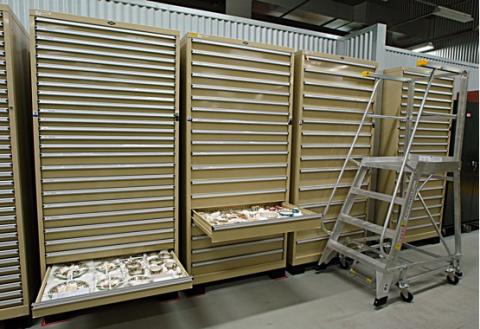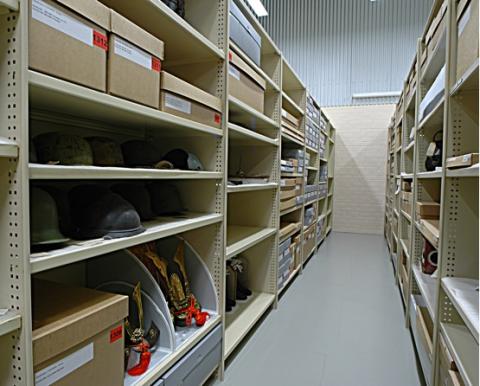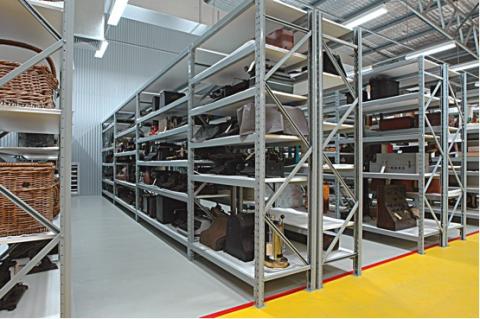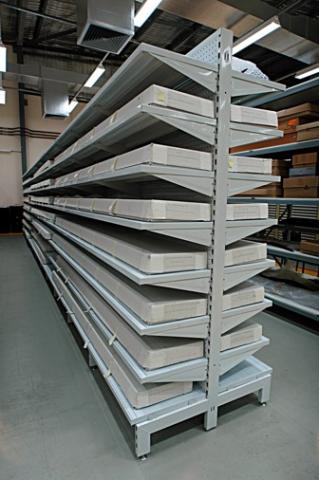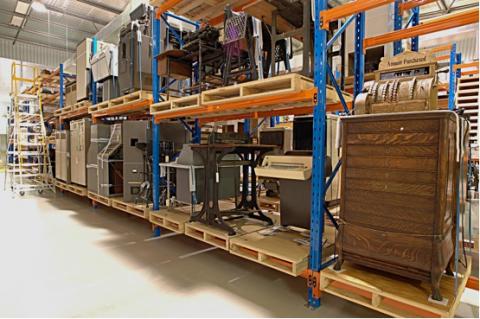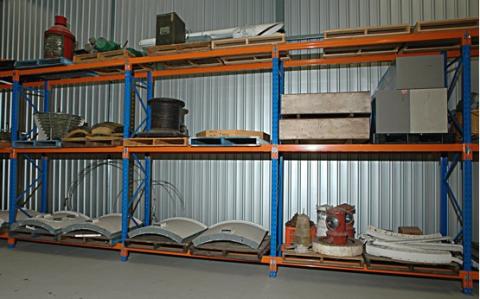Storage Furniture
Few institutions can afford custom made storage systems. The standard powder coated metal storage systems available commercially are ideal for museum storage and come in a range of sizes. Take time to work out and plan the requirements of a specific collection and to determine what may be required in the future. Then use this information to determine the best configuration of storage furniture for the store room(s).
Powder coated metal storage furniture is preferable to wooden furniture as it is inert. Formaldehyde in many types of wood and composite wood materials, such as chipboard and medium density board, reacts to form formic acid which is harmful to many materials. If wooden furniture is the only option, seal all surfaces with an aluminium foil laminate or a water-based polyurethane. Allow the polyurethane to off gas for four weeks before putting objects in the furniture.
The storage system required depends on the sizes of the objects to be stored and typically may comprise:
- metal cabinets of drawers (BAC™ type) for small objects;
- standard commercial type or compactus shelving for medium sized objects;
- long span shelving for medium to large objects and possible open storage;
- cantilever shelving for extra long objects such as spears;
- pallet shelving for large objects; and
- free standing floor space for very large objects.
Ideally, objects should be stored according to their classification in each of the above types of storage.
Metal Drawer Cabinets
There are systems of powder coated metal drawers available that are state of the art for the storage of smaller objects (e.g. BAC™ system). If these are affordable, careful planning is needed to get the most useful configurations of drawer heights for the objects to be stored. Such drawers will usually require dividers within each drawer. Custom made modular specimen trays that configure into a drawer are very useful (Figure 1).
Figure 1: BAC™ units of drawers of different heights fitted with modular specimen boxes (image courtesy Jon Carpenter, WA Museum).
Standard Commercial Type or Compactus Shelving
Choose the shelving type based on the objects to be stored and the best configuration for the storage space. Compactus shelving maximises space but involves movement of the shelving units which in some instances might not be desirable. If the ingress of dust is a problem use either compactus units or fit dust covers or curtains to the front of shelving. Use finely woven and washable materials such as cotton sheeting or Tyvek® for dust covers or curtains.
Medium sized objects are best stored within boxes on these shelves. Boxes can be made of cardboard, archival board or polypropylene (Figure 2). Standard boxes are available or can be custom made to configure with the shelving size.
Figure 2: Lightweight metal shelving units with objects, cardboard and polypropylene modular boxes. Note the space efficiency (image courtesy Jon Carpenter, WA Museum).
Long Span Shelving
Providing there is no ingress of dust into the storage area then store medium to large objects unboxed on open shelving. Depending on the size of the store and collection to be stored these could be standard shelving as above or long span shelving as shown below (Figure 3). Line the shelves with 2 mm thick polyethylene foam sheeting such as Cell-Aire® to provide cushioning and to reduce skidding on the shelf surface.
Figure 3: Long span shelving with objects of similar height of the same classification stored on each shelf (image courtesyJon Carpenter, WA Museum).
Store objects in boxes if there is dust ingress into the storage area. Compactus shelving is not recommended for open storage due to the added risk of damage during the movement of the compactus units.
Cantilever Shelving
There are some groups of objects such as aboriginal spears that might require specialised continuous shelving such as cantilever shelving (Figure 4). This provides ease of access to the objects without the massiveness of long span shelving.
Figure 4: Cantilever shelving for the storage of long items (image courtesy Jon Carpenter, WA Museum).
Pallet Shelving
Use pallets and pallet racking for objects that are too large to store on shelves (Figure 5). Avoid the use of commercially available pallets as these are usually of poor quality and therefore unsuitable for use in collection areas. Instead custom make your own using exterior grade ply coated with water-based polyurethane. Ensure that any custom made pallets comply with industry standards regarding weight bearing loads and construction.
Figure 5: (a) Modular pallet racking with half pallets and third pallets in the middle bay. Note the space efficiency.
(b) Example of poorly stored objects on pallet racking – space inefficient storage (images courtesy Jon Carpenter, WA Museum).
Free Standing Space
Vehicles, boats, industrial machinery and other objects that are too large or too heavy to store on pallet racking will need to be stored on the floor. Ideally these objects should be slightly raised from the ground, perhaps on cradles or pallets. While this is not very space efficient it is necessary. Use dust covers.













